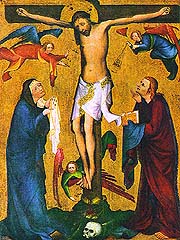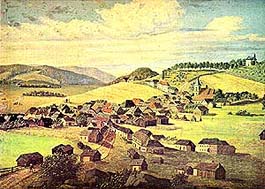Cultural History of the Český Krumlov Region

The Český Krumlov region was, due to its isolated position and less suitable conditions, not populated until the Middle Ages, even though smaller settlements grew up here even in the Stone Age. The main wave of colonisation did not come here until the 13th century, and then also cultural life started the blossom here. From the Romanesque times only fragments remained, which were not swallowed up by the rebuilding of later dates.
The Gothic period meant great expansion in the cultural and economic sphere. The centre of the region was Český Krumlov, and became the capital city of the secular lordships, from here the influence spread into the local village population. An important role was also played by the Church, which influenced all aspects of the lives of the believers. Both these authorities were the customers for and the patrons of the art work.
 Most of all, the
Cistercian monasteries in Vyšší Brod and Zlatá Koruna, which were
established in the second half of the 13th century were the centres
of civilisation. The local scrivener offices contributed towards
supplying and formed the traditional literature, also the musical
tradition was born here, monastery libraries, especially the one in
Vyšší Brod were valuable. Both monasteries represent together with
other castles, chateaux, fortified settlements, churches and
mansion houses the Gothic style, which is accompanied with
sculptures, carvings and painting works of local and foreign
origin, made in the so-called Beautiful style.
Most of all, the
Cistercian monasteries in Vyšší Brod and Zlatá Koruna, which were
established in the second half of the 13th century were the centres
of civilisation. The local scrivener offices contributed towards
supplying and formed the traditional literature, also the musical
tradition was born here, monastery libraries, especially the one in
Vyšší Brod were valuable. Both monasteries represent together with
other castles, chateaux, fortified settlements, churches and
mansion houses the Gothic style, which is accompanied with
sculptures, carvings and painting works of local and foreign
origin, made in the so-called Beautiful style.
During the 16th century, the comfortable and cheerful Renaissance style was placed against the strained features of the Gothic period. Gothic castles (Český Krumlov and Rožmberk) were being rebuilt, summer houses and hunting lodges were being built (Červený Dvůr), their walls were decorated with Renaissance paintings and galleries of family portraits and everywhere there was the sound of music. Similar things happened even in the town environment. The church buildings accepted the changes mainly in the Late Gothic period, therefore the Renaissance alterations touched them only slightly. Again the main cultural centre was Český Krumlov during the reign of the last Rosenbergs, Wilhelm and Peter Wok.
The Baroque period meant a return to Christ, and an increased interest in sacral art. There were changes, but also newly built monasteries, convents, churches and chapels, Stations of the Cross and pilgrimage places (Kájov). The art works which were made in the region of Český Krumlov were developed, but did not overstep the average creativity of those days. It is worthwhile to mention the creativeness of sculptors Matěj Václav Jäckel and Jan Antonín Zinner. Concerning secular village architecture, the Baroque style, as can be said, has mostly decorative function. From the end of the 18th century it is possible to follow the musical life around the village parish churches.
From the beginning of the 19th century, the region of Český Krumlov began to be in the economic and cultural sphere a peripheral region. At the turn of the 18th and 19th centuries, there is especially folk theatrical culture, the play of "Hořické Pašijové Hry" (Passion Plays of Hořice) is well known. The most famous literary person is obviously Adalbert Stifter, a native of Horní Planá. For the art works a folk form of glass painting is typical. We can also mention the stay, outside Krumlov, of the painter Charlese Louise Philippot.

|

|
After the German population was expatriated after the second world war, and several cultural institutions were liquidated, the cultural life in the region greatly suffered. After 1989 the situation improved.
Further information :
Architecture
in the Český Krumlov Region
History
of Painting in the Český Krumlov Region
History
of Sculpture in the Český Krumlov Region
History
of Music in the Český Krumlov Region
History
of Theatre in the Český Krumlov Region
History
of Literature in the Český Krumlov Region
History
of Culture in the Český Krumlov Region
(mko)





